![]()
![]()
![]()
Use LEFT and RIGHT arrow keys to navigate between flashcards;
Use UP and DOWN arrow keys to flip the card;
H to show hint;
A reads text to speech;
42 Cards in this Set
- Front
- Back
|
Before entering the citric acid cycle, glucose must be converted toooooooooo
|
->>>>>>> Pyruvate -> Acetyl-CoA
|
|
|
Before entering the citric acid cycle, Fatty and Amino acids must be converted INTO
|
Acetyl-CoA
|
|
|
Fatty Acid and Glucose release electrons when converting to Acetyl-CoA, this regulates...
|
Electorn transport chain.
|
|
|
Pyruvate -> Acetyl CoA is driven by
|
Pyruvate Dehydrogenase
Oxidation of NADH + H+ -> NAD+ |
|
|
Structure of Pyruvate
|

|
|
|
Structure of Acetyl-CoA
|

|
|
|
Pyruvate Dehydrogenase Complex
Location - Type of Reaction - Product - |
Mitochondrial Matrix Enzyme
Oxidatively Decarboxylates Pyruvate Forms Acetyl CoA IRREVERSIBLE SO YOU HAVE TO KNOW THIS ONE |
|
|
Catalytic Coenzymes
|
Thiamine Pyrophosphate (TPP)
Lipoic Acid FAD |
|
|
Nicotonic Acid
|
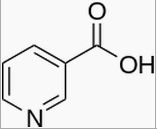
*Also called Niacin or Nicotinamide-based enzymes
1. Redox Coenzyme 2. It's part of NAD and NADP 3. Universal Electron Carrier 4. Dehydrogenases |
|
|
Riboflavin
|
1. Redox Coenzyme
2. Component of FMN and FAD 3. Donor or Acceptor (2 Hydrogens instead of 1 in nicotonic acids) 4. Enzymes are called Flavoproteins - dehydrogenase, oxidase, hydroxylase |
|
|
Nicotonic Acids vs Flavoproteins
|
1. Both are Redox Coenzymes
2. Flavoproteins can donate or accept 2H vs 1H 3. Flavoproteins are not only dehydrogenases, but- also oxidases and hydroxylases 4. FMN/FAD vs NAD/NADP |
|
|
Stoichiometric Coenzymes
|
CoA and NAD+
Function as substrates |
|
|
Two parts of Acetyl CoA
|
1. Acetyl Group - C2H3O-
2. Coenzyme A - b-mercaptoethylamine, pantothenic acid, 3,5-ADP |
|
|
3 Steps of Acetyl CoA from Pyruvate
|

1. Decarboxylation - Remove CO2
2. Oxidation - Remove 2e- 3. Transfer to CoA - Sulfur bond in between |
|
|
3 Enzymes in Pyruvate - Acetyl CoA formation
Chain # Prosthetic Group Reaction Catalyzed |
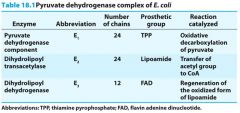
|
|
|
Decarboxylation of Pyruvate
|

FIRST STEP TO ACETYL COA
Catalyst - Pyruvate Dehydrogenase Pyruvate combines with ionized form of TPP *NOTICE THE REDUCTION OF THE CARBONYL |
|
|
Oxidation of Hydroxyethyl-TPP
|

SECOND STEP TO ACETYL COA
TWOCARBONFRAGMENT is Oxidized and transferred to dihydrolipoamide Enzyme - dihydrolipoyl transacetylase (binds lipoic acid to its lysine residue to form hihydrolipoamide *NOTICE THE SULFUR GETS HYDROGENATED AND THE DISULFIDE BOND BREAKS |
|
|
Transfer from acetyllipoamide to CoA
|

THIRD STEP TO ACETYL COA
-Dihydrolipoyl Acetylase (E2) catalyzes transfer of acetyl group from acetyllipoamide to CoA -Dihydrolipoamide dehydrogenase reoxidizes dihydrolipoamide to lipoamide. In this process, FAD is reduced, which then reduces NAD+ |
|
|
Benefit of structural integration for Pyruvate dehydrogenase complex
|
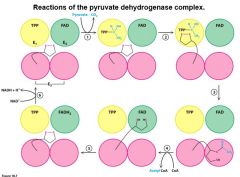
lipoamide "arm" allows rapid movement of substrates and products from one active site to another
1. RXN is facilitated by having active site in proximity 2. Reactants do not leave the enzymes until product is formed 3. Constraining the reactants minimizes loss due to diffusion and minimizes side reactions. 4. Regulation is more efficient because regulatory enzymes (kinase/phosphate) are part of the complex. |
|
|
What can we do with acetyl CoA?
|
CANNOT CONVERT IT BACK TO GLUCOSE
Convert to CO2 Convert to/from Lipids |
|
|
Mechanisms of regulating PDH
|
1. Energy. Phosphorylation of PDC(kinase) inactivates. Dephosporylation(phosphatase and water) activates
2. Energy charge Acetyl CoA, NADH, ATP allosterically inhibit Pyruvate and ADP feed forward |
|
|
Other names for Citric Acid Cycle
|
Krebs Cycle
Tricarboxylic Acid |
|
|
Stages of Citric Acid Cycle
|
Stage 1 - 2 oxidative decarboxylations
Stage 2 - Regenerate Oxaloacetate |
|
|
Both stages of the citric acid cycle generate
|
ATP, which fuels the synthesis of ATP
|
|
|
Products from citric acid cycle
|
2 CO2
8 e- 1 ATP |
|
|
CAC Step 1 (Stage 1)
|

CITRATE SYNTHASE catalyzes the CONDENSATION of Oxaloacetate (4C) and acteyl CoA
Oxaloacetate+citrate synthase -> citryl CoA with proper active site -> citrate and CoA |
|
|
CAC Stage 1 (Stage 1)
|

ACONITASE catalyzes the isomerization of citrate into isocitrate.
|
|
|
CAC Step 3 (Stage 1)
|

***ISOCITRATE DEHYDROGENASE*** catalyzes the OXIDATIVE DECARBOXYLATION of isocitrate, forming alpha-ketoglutarate and capturing the high-energy electrons as NADH
|
|
|
CAC Step 4 (Stage 1)
|

***ALPHA-KETOGLUTARATE DEHYDROGENASE COMPLEX*** catalyzes the synthesis of SUCCINYL CoA, generating NADH
***Very similar to pyruvate dehydrogenase complex |
|
|
CAC Step 5 (Stage 2)
|
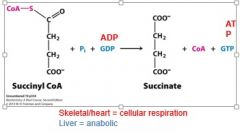
SUCCINYL COA SYNTHASE (THIOKINASE) catalyzes cleavage of thioester linkages and concomitantly forms ATP
|
|
|
CAC Step 6-8 (Stage 2)
|
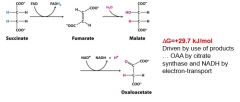
SUCCINATE DEHYDROGENASE, FUMARASE, MALATE DEHYDROGENASE successively oxidize succinate to form oxaloacetate
|
|
|
Synthesis of oxaloacetate is driven by...
|
use of OAA by citrate synthase
use of NADH by electron-transport |
|
|
Net Reaction of Citric Acid Cycle
|

|
|
|
Giant Hideous Chart of CAC
|
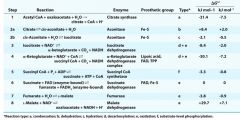
|
|
|
Control Points of Citric Acid Cycle
|
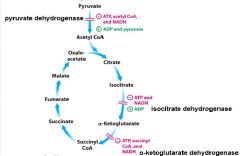
|
|
|
Biosynthetic Precursors from CAC
|
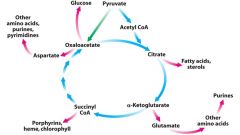
|
|
|
How to convert pyruvate to oxaloacetate?
|
Anapleurotic Reactions
Pyruvate + CO2 + ATP + H2O with PYRUVATE CARBOXYLASE Oxaloacetate + ADP + Pi + 2H+ Oxaloacetate can also form PEP (phosphoenolpyruvate(PEP) during gluconeogenesis) |
|
|
What's the point of the glyoxylate cylcle?
|
Allows plants and bacteria to convert fats into carbs
|
|
|
Compare net yields of CAC and Glyoxylate Cycle
|
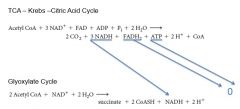
|
|
|
Glyoxylate Pathway
|
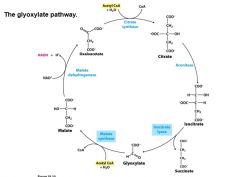
|
|
|
Inhibitors of pyruvate dehydrogenase
|
PDK phosphorylates PDH
|
|
|
Factors that enable PDH
|
Active PDP activates PDH
Inhibiting PDK inhibits phosphorylation |

